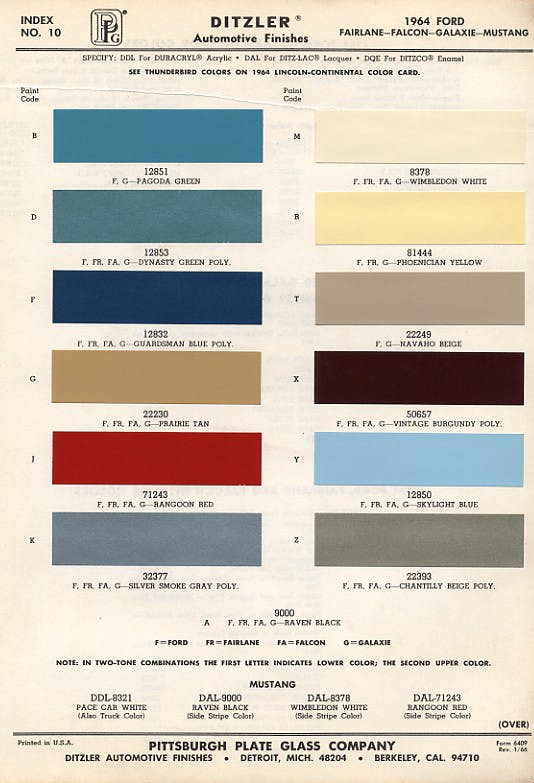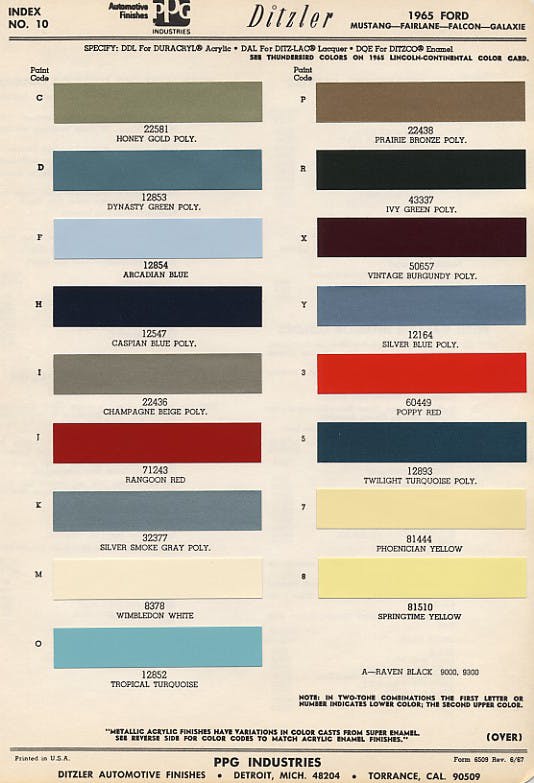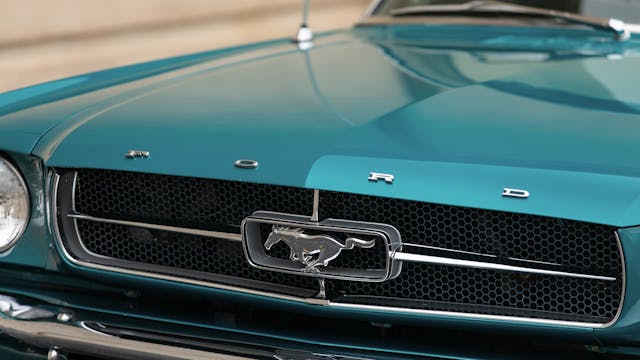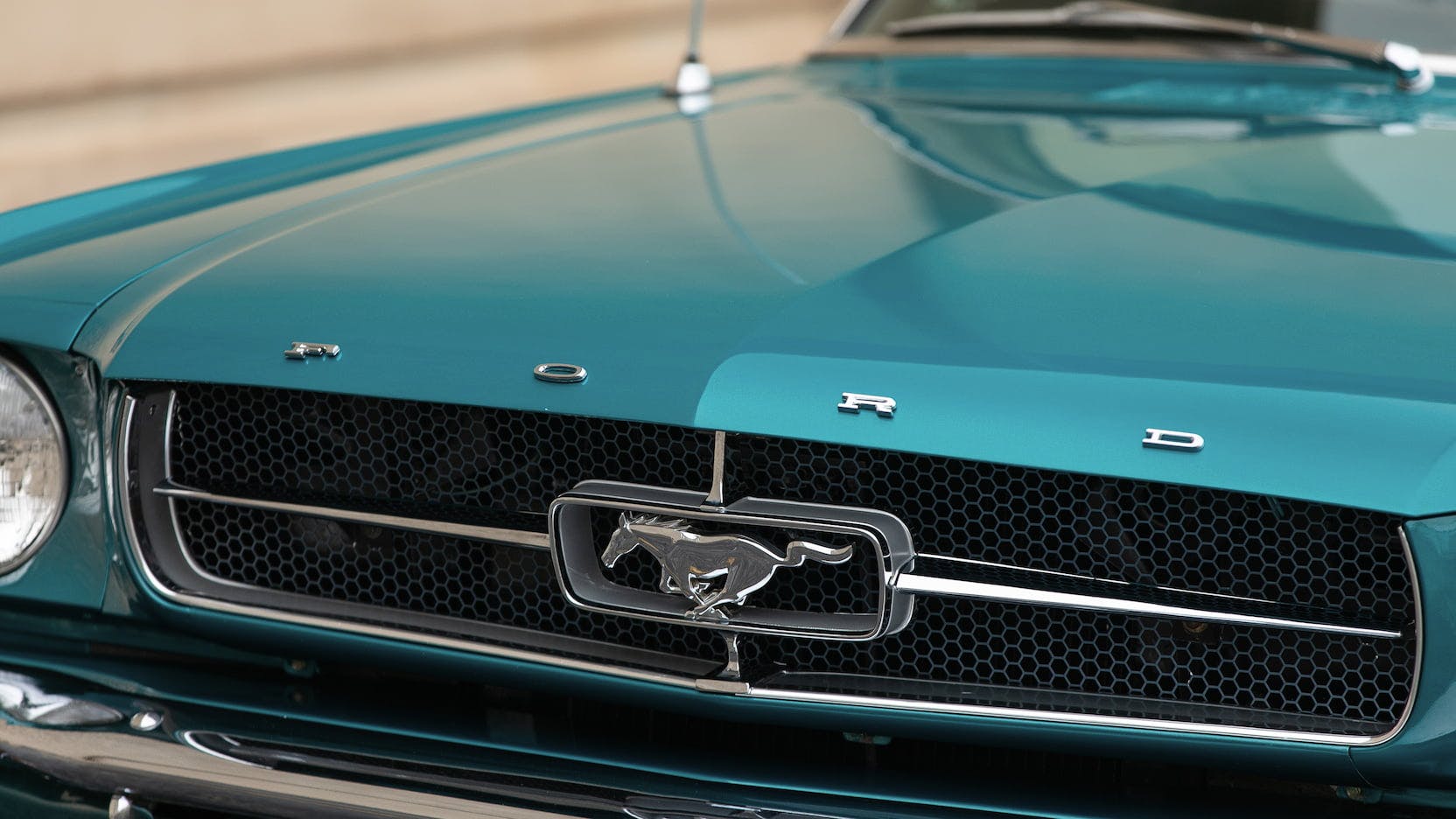Media | Articles
Which Original Mustang Paint Color Is Worth the Most?
April 17 marks sixty years since the Ford Mustang’s public debut at the 1964 New York World’s Fair. The original pony car immediately became a pop-culture and automotive phenom, and it remains one of the most impactful cars in history. We’re celebrating with stories of the events surrounding the Mustang’s launch, the history of the early cars, and tales from owners. Click here to follow along with our multi-week 60 Years of Mustang coverage. —Ed.
When the Ford Mustang debuted sixty years ago at the World’s Fair in New York on April 17, 1964, it became an overnight hit. However, though Ford accurately targeted the up-and-coming baby boomer generation with the car’s avant-garde design and features, the Mustang wore many colors that were more ’50s pastels than ’60s shock. The discrepancy between the car’s image and its colors has complicated the picture for Mustang enthusiasts ever since. Many owners have opted to repaint their Mustangs, while others have sought cars painted in a rare, original shade. Which original colors are most likely to be covered with a repaint, and which original colors are most valuable? Read on.
Marketplace
Buy and sell classics with confidence
For the 1965 model year, the Mustang was available in 24 colors (a few, like Pagoda Green, were only available on the 1964 ½ cars). Yellows, golds, blues, turquoises, beiges, reds, and greens were available, along with more common colors like black, white, and silver.


Some of the original colors aren’t especially valued by enthusiasts today—specifically, Silver Smoke Gray and Silver Blue. To reach that conclusion, we reviewed auction data from over 700 sales, going back to 2014, and compared those results to condition-appropriate values from the Hagerty Price Guide, whether the car in question was a six-cylinder or a K-code, a notchback or a convertible. We found that Silver Blue is worth just 5 percent more on average, and Silver Smoke Gray just 8 percent more.

Rarely seen or ordered, Prairie Bronze is worth nearly one-third less on average, and so is Sunlight Yellow. Vintage Burgundy is popular (almost 50 out of the 700 cars in our data set wore it) but typically worth 16 percent less on average. Conversely, Wimbledon White is relatively common (almost 40 transactions) but worth 16 percent more. Twilight Turquoise isn’t as common (about 20 sales), but worth 19 percent more. Dynasty Green is rare, with just three sales in the past ten years, and worth 24 percent more. A car wearing its original Raven Black is also worth a lot, despite being somewhat common (15 sales): This color is worth nearly 30 percent more on average. The prize for the most valuable color goes to the rarely seen, 1964 ½-only Pagoda Green, worn by only one car out of the 700: This color is worth 61 percent more.
If we group together all the colors, whether original or not, we see that yellows are worth the least on average, followed by reds and blacks, which are very common. However, white is more valuable on average, even though it’s frequently used, and so are orange, turquoise, and green. Gold, blue, green, and silver are in the middle.

What original Mustang colors are most likely to be painted over? Surprisingly, Wimbledon White: Though it is worth 16 percent more than other original colors, on average, it is replaced by a different one almost 75 percent of the time in our data set. Silver Blue, Silver Smoke Gray, Honey Gold, and Prairie Bronze are painted over nearly as often. Given the popularity of red in our dataset (150+ transactions), Poppy Red and Rangoon Red are rarely swapped out. Valuable Raven Black is also rarely painted over, as are Ivy Green and Twilight Turquoise.

What colors do owners typically use for a repaint? Red is the most popular shade, picked almost one-third of the time. It is followed by blue, white, black, and silver. Though Wimbledon White is often painted over, it is also occasionally picked as a repaint shade.

Which 1965-model-year Mustang color is most valuable to you?
***
Check out the Hagerty Media homepage so you don’t miss a single story, or better yet, bookmark it. To get our best stories delivered right to your inbox, subscribe to our newsletters.














I re-painted my 1965 Mustang Fastback that was Silver Blue to The 1966 color found only on the GT350 Hertz Mustang in Sapphire Blue. I didn’t put the Gold stripe that was found on the Gt 350. I get TONS of compliments on the Sapphire Blue color, usually because you never see that color since it was a 1 year color on an Iconic Mustang.
“C” Code color Pace Car White is probably the rarest ‘64.5 shade.
Even if condition was taken into account, the sample gets very small in some colors to be representative. The fact that Wimbledon white is priced at a premium bit, at the same time, it’s the most repainted would suggest that color is not the driving factor behind the premium, but rather other issues
It would be great to see the same survey applied to the next years, especially when special colors came out. Thanks for this one, very interesting
My 65 A code fastback was Caspian Blue when it was new and still is. I love that color. It has had a complete restoration and gets lots of positive comments on the color. I have had many many Mustangs over the years and this one is by far my favorite.
I could swear my 66 convertible was an offshoot of the 65 poppy red. It was called “signal flare red”, I believe. Does anyone remember this or am I all wet? Thanks…
Years ago a co-worker bought a Smoke Gray ’65 convertible with a white interior in Kentucky and drove it home to Michigan. He loved everything about it but the color, and expressed his doubts concerning a color change due to possible loss of value. I asked about the car’s Smile Factor- did it make him smile when he opened the garage door?
After several days of contemplation we painted it Rangoon Red. No complaints or regrets.
deedub- I was working at a Ford dealer in the mid-60s and I seem to recall Signal Flare red on the ’66 models. Awesome color as I remember, and popular as well.
I have a ‘66 convertible in Sahara Beige. Never seen another one and most people seem to like it at shows.
47 years ago I started a restoration on my’66 fastback the car was red and discovered the original colour was nightmist blue when I took the fenders off there was the original colour on the cowl. After completing the build I decided the original colour will stay and I never looked back I still have the car and love the colour!
I had a 66 Mustang 289 in silver blue that I bought in 73 from my father. He had bought it used a few years before. It ran great but looked like it had skin cancer. I had it repainted, but a few months later it looked as bad as before. It developed other problems, so I sold it and got a 71 Beetle. I seem to remember other Mustangs with a similar paint problem. Question: Was there something that Ford had done, in priming perhaps, that caused this problem on Mustangs of that era? I’m not really a car guy, so keep any reply in layman’s language.
In 63 champagne washed out in the Ford line of cars. I understand they recalled that color for repaint. I have a 63 Country sedan wagon dad bought new in Burgundy, that was very popular , also a 63 Galaxie convertible originally in champagne we repainted Burgundy. We get several favorable compliment’s on it also.
I think Wimbledon White is the classiest color and looks amazing with the contrast of black tires and any color soft top. It makes for a great canvas for the badging and chrome to stand out on. The color has cool shade to it and is not too bright a white.
One of the chief reasons for repainting a 1964 1/2 through 1966 Mustang is that the original paint was in sorry shape and, regardless of the original color, looks horrible. In fact, some of the metallic colors didn’t look very good straight from the factory. I’ve restored Poppy Red and Wimbledon White 1965 Fastbacks, changing both to Silver Blue. Maybe I’m spoiled by the modern basecoat/clearcoat paint technology but I have never seen an original in Silver Blue look as good as my repaints.
I have my Dad’s 1965 convertible that was originally painted Tropical Turquoise. He always disliked the color and repainted it Vintage Burgundy in the 70’s or 80’s.
When the car became mine, the Vintage Burgundy was in poor condition – so we repainted it back to the original Tropical Turquoise in 2010.
We confirmed the color match when we exposed the steel windshield frame (concealed under the stainless-steel trim and never exposed to sunlight). The result was a perfect match.